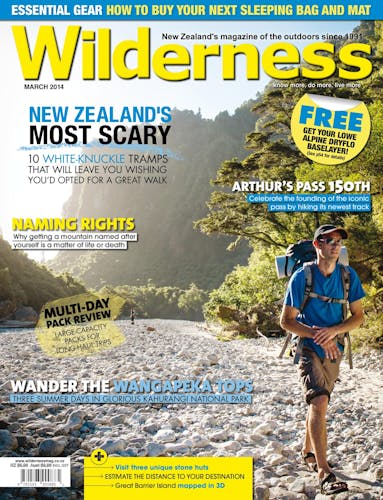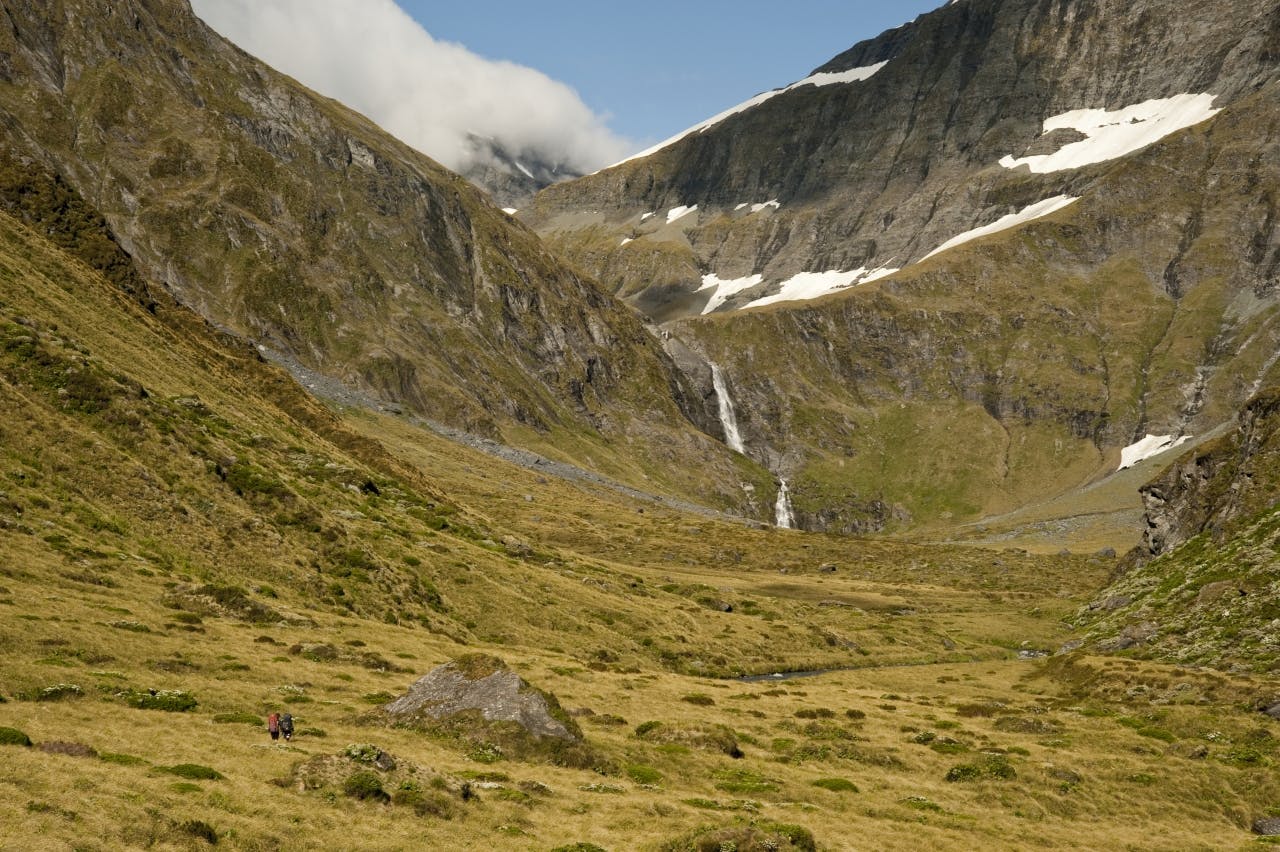If you like living on the edge, you must try New Zealand’s scariest tramps
Words and images by Shaun Barnett, Geoff Spearpoint, Richard Davies and Mark Watson
Waterfall Face, Mt Aspiring National Park
Relentless exposure for those wanting a tough alpine crossing
The notorious Waterfall Face presents a serious and challenging obstacle for trampers tackling the Rabbit Pass tramp from the Wilkin to the Matukituki. Your reward is being among some of the finest tramping terrain in the country, with peaks like Taurus, Pickelhaube and Mt Twilight above.
The headwaters of the Wilkin River South Branch meander through idyllic tussock flats before plunging abruptly over twin waterfalls, 90m and 35m in height. Bluffs on either side force trampers to negotiate the so called Waterfall Face. My first encounter with the face was a descent after heavy rain; conditions that Moir’s Guide North called dangerous. Parts of the route terrified me and certainly a fall near the top would likely be fatal. A later ascent in fine conditions felt much more comfortable.
Sporadic waratahs (several of them bent by avalanches) mark the route, which weaves between bluffs on the true left of the waterfalls, ascending to a point a few hundred metres west of the lip, following a narrow ledge for the last section.
The route now sees enough tramping traffic for the footholds to be well-defined. While there’s nothing useful for securing a belay, experienced trampers with a reasonable head for heights should not experience undue difficulty. An ice-axe provides a useful means of security.
Once up the Waterfall Face, trampers usually breathe a sigh of relief, although a descent down Rabbit Pass awaits. A short rope can be useful here for lowering packs on the most awkward section.
Selborne Range traverse, Mt Aspiring National Park
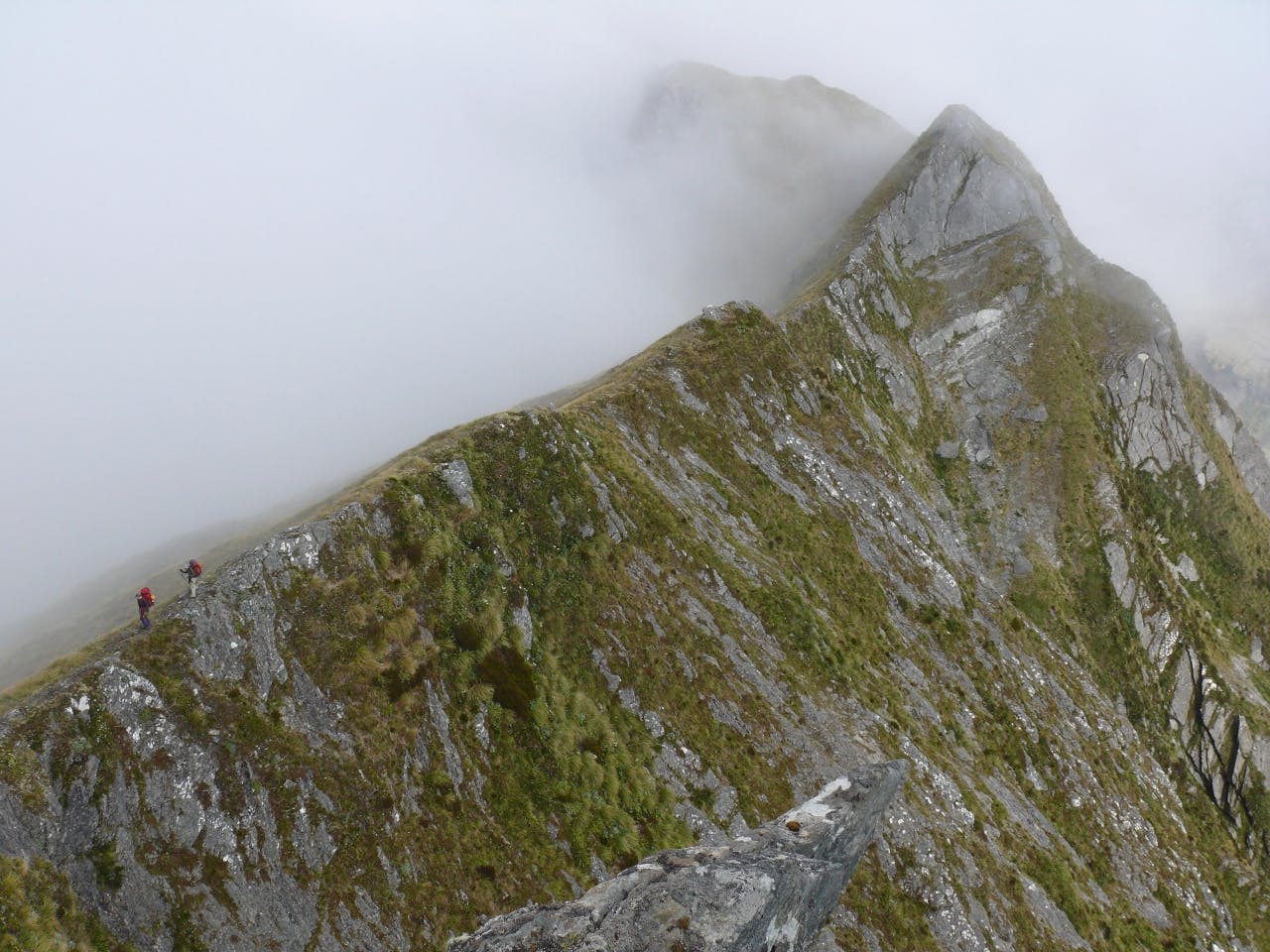
Trampers traverse the scary Selborne Range. Photo: Geoff Spearpoint
An isolated transalpine traverse in South Westland
From the lower Waiatoto River, climb Rampart Ridge onto the northern Selborne Range. Then ride the Selborne as it bucks its way towards the Main Divide at Trident Peak, several days away. It’s exhilarating, enhanced by the scariness of being out on a limb on the tops high above untracked rivers, with big drops on either side, narrow arêtes to traverse, bluffs to climb and the uncertainty that a way can even be found along it at all.
Parties will need a rope in several places. Small snowfields are crossed between Mts Selborne and Dispute. Bluffs, a narrow ridge and steep loose rock leading onto Dispute keep the concentration up and the scary factor going right to the end. Finish by crossing the Main Divide and descending to Lake Castalia, the Wilkin Valley and Makarora.
Despite the fright, there are rich rewards. Undiscovered campsites, views from Jackson Bay to Aoraki/Mt Cook and Aspiring, and the buzz that comes from successfully negotiating the dodgy unknown.
Giffords Crack, Fiordland National Park
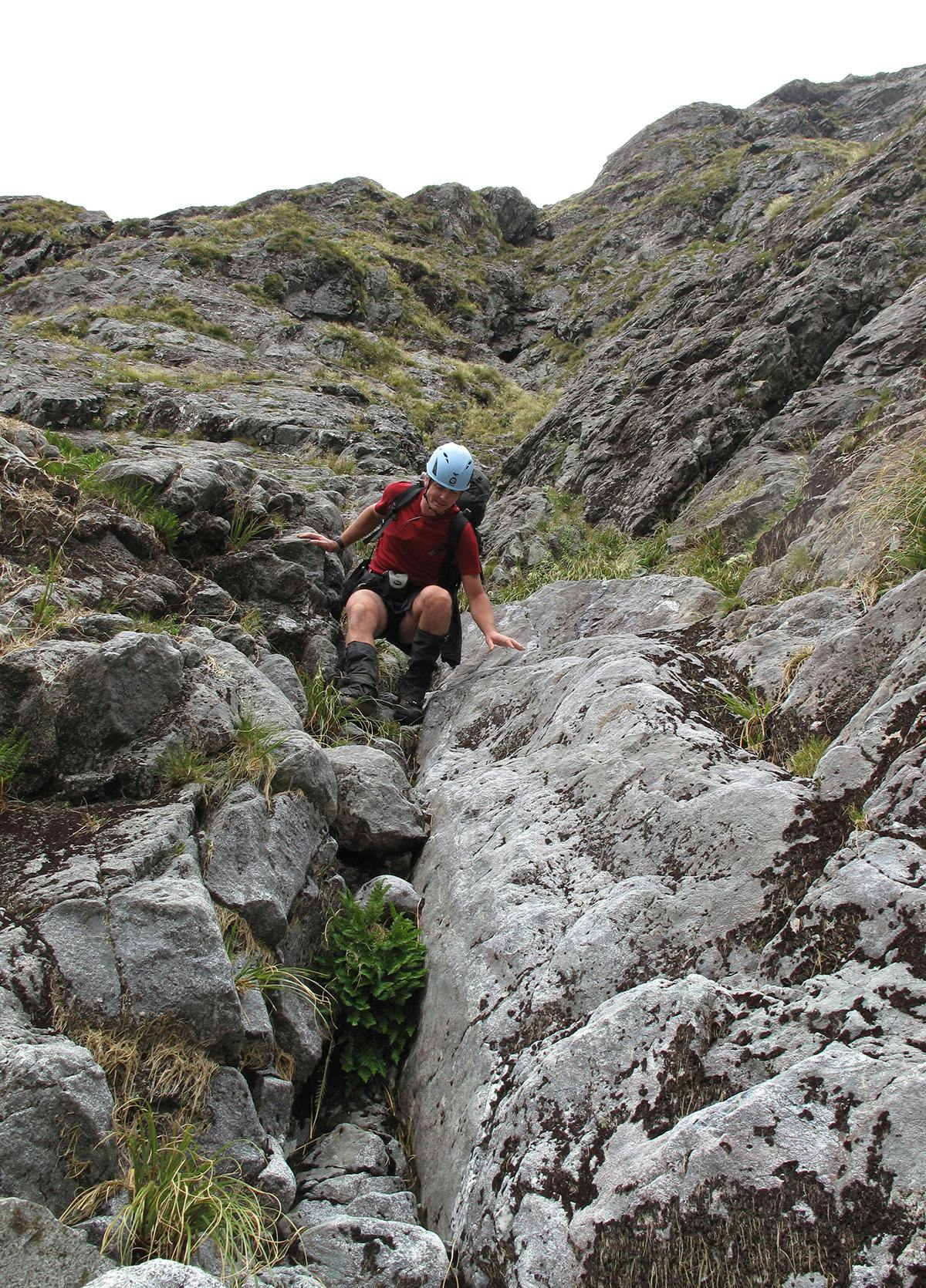
Descending the rocky chute that is Gifford Gap. Photo: Richard Daviss
A demanding and committing scramble up an improbable route
Giffords Crack (marked on maps as Gifford Gap) is the key to the almost impenetrable cirque at the head of Moraine Creek, and gives access to a breathtakingly exposed route to the head of the Hollyford. This is climbing country and a night soaking in the atmosphere at the rock biv at the southern end of Lake Adelaide will give you the necessary mountain-man courage to attempt the Crack,
a steep rocky chute in the bluffs.
Initially, inside the Crack, there is a lot to hold on to. About a third of the way up, things start to heat up when you have to climb out and traverse across two quite difficult moves. A slip here would be fatal, but there are a couple of bolts if you have belay equipment.
Once the second crux move is completed, a good tussock ramp leads up to Adelaide Saddle, 1398m. A steep exposed rocky ridge keeps you scrambling up over 1879m Barrier Knob, then it’s just exposed snow and slabs down to Gertrude Saddle and probably a lie-down.
Broken Axe Pinnacles, Tararua Forest Park
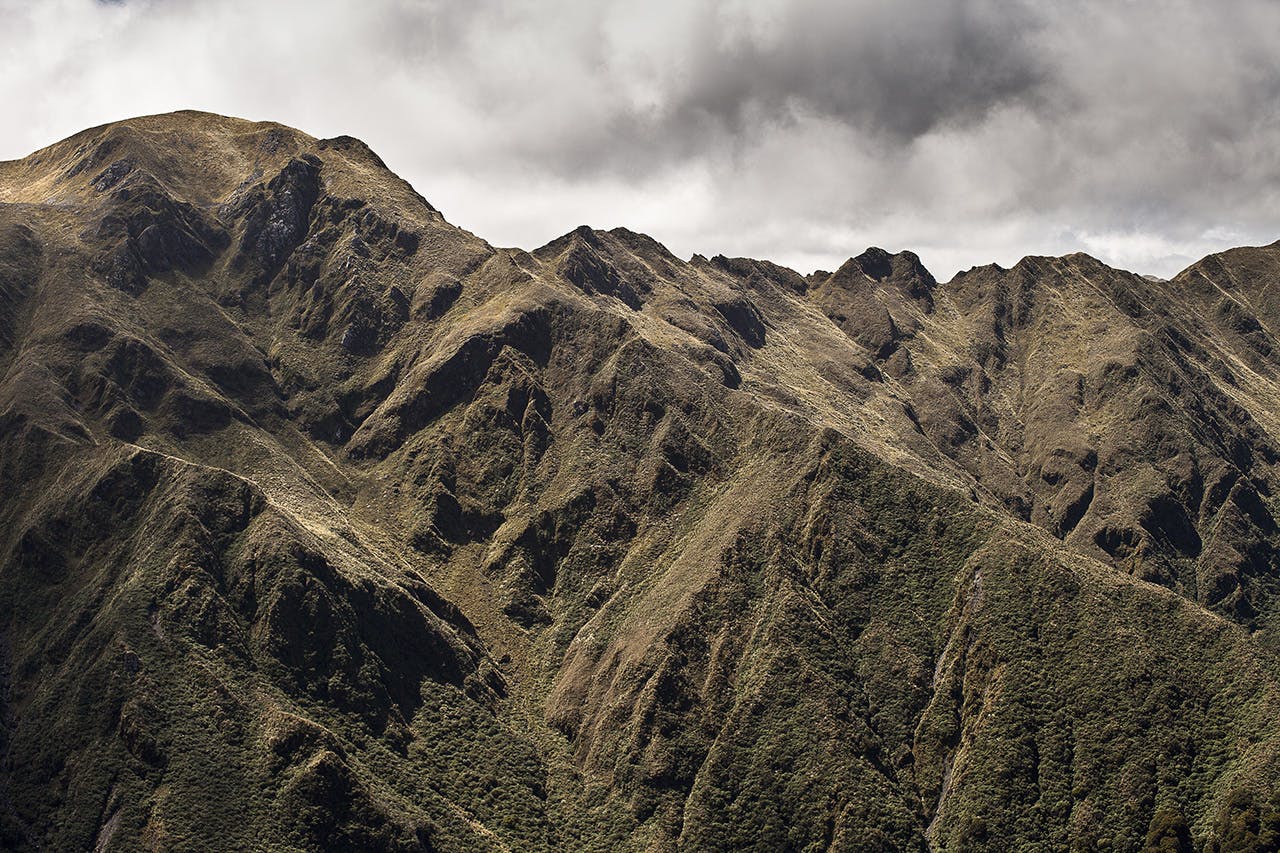
The Broken Axe Pinnacles is an essential, though frightening, Tararua experience. Photo: mark Watson
Riding a classic Tararua ridgeline between McGregor and The Three Kings
While a lot of Tararua tramping country can be described as rugged, but reasonably benign from an exposure perspective, the direct traverse over the Broken Axe Pinnacles is not for those who like their feet on level ground. In recent years DOC has made a sidle track, making the traverse no longer mandatory. But for the traditionalists, tackling the pinnacles head on is an essential Tararua experience.
Approaching from the south, a steel stanchion on the summit of the highest pinnacle will aid pack lowering down the northern (steepest) section if necessary but confident trampers will usually do without. Approached from the north, this section is simply steep, ledge-to-ledge climbing/scrambling – with a few pulls on tussocks to help you up. If you get up this okay, the rest is exposed but technically trivial.
Haystack Ridge traverse, Kahurangi National Park
A high ridge traverse above a remarkable landscape.
The Thousand Acres Plateau and its smaller neighbour, the 100 Acres Plateau, are two incredible limestone features in Kahurangi National Park. Adventurous parties can tackle the high mudstone ridges above the plateaux.
From the upper Matiri River, a grovelly bush bash gives access to the ridgeline. Initially, travel is easy but keep an eye on the steep slips from the cataclysmic 1929 Murchison earthquake. Approaching Haystack, things start to get scary with a steep series of mudstone steps rising up to the Haystack.
A head-on attack isn’t viable and to the left steep bluffs plunge down to the plateau. So go right which, though not as steep, will have you scrabbling on crumbly, flaky mudstone.
Getting back on tussock has never felt so good. The summit of the Haystack is an airy place with big drops on either side and it’s a relief to hit Larrikin Creek Hut.
Sawtooth Ridge, Ruahine Forest Park
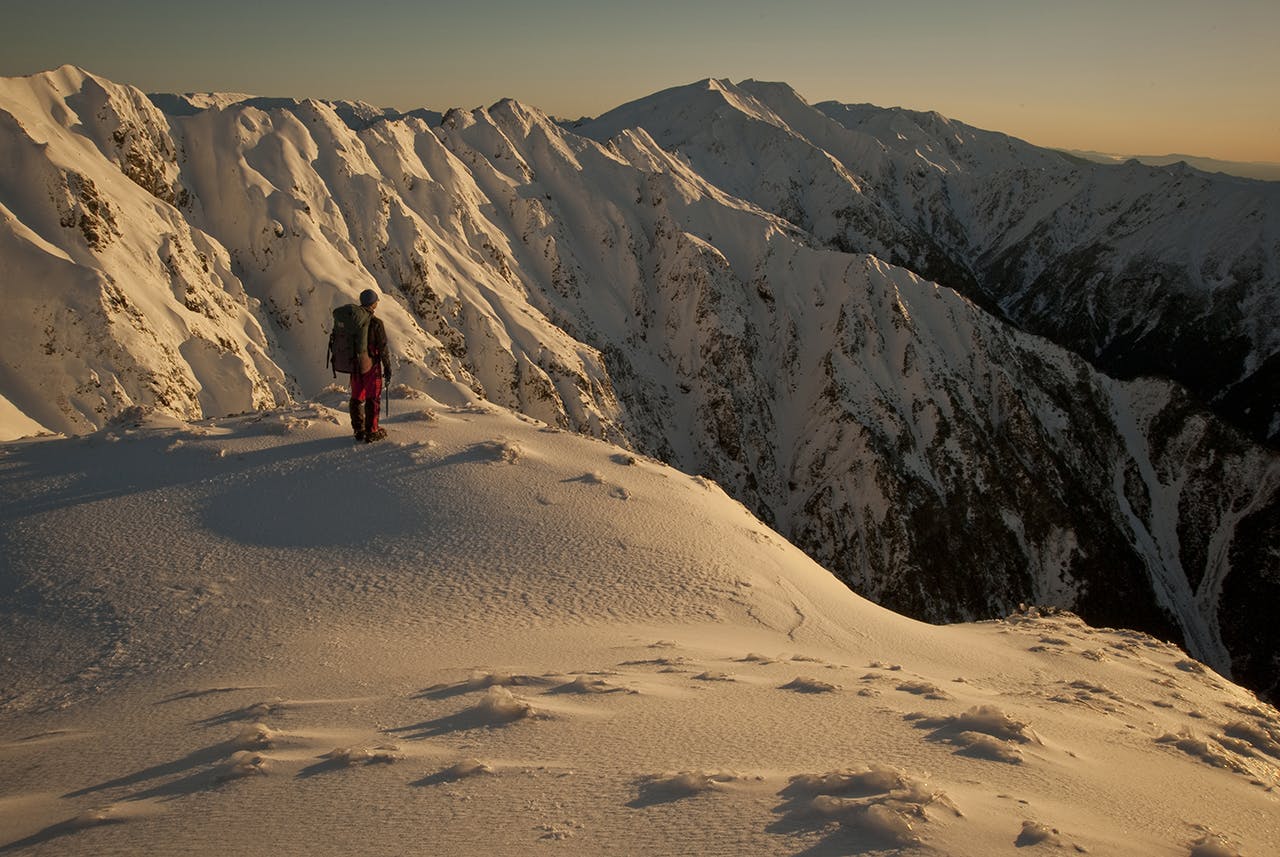
Better come back in summer. Heavy winter snow cloaks Sawtooth Ridge. Photo: Shaun Barnett
Adventurous tramping on a formidable ridge
A jagged section of the Ruahine Range, the aptly named Sawtooth Ridge looks formidable in profile, and offers adventurous tramping.
Fortunately, the ridge crest is easier than its profile suggests and most experienced trampers will find no real problems traversing the Sawtooth in summer conditions. A well-trodden route ducks around several rocky outcrops, sometimes sidling on narrow ledges, but staying mostly near the crest. Cross the ridge on a windy day though, and a straightforward traverse can become a nightmare.
Both my summer traverses have occurred in mist, which, while reducing the views, did cut down the sense of exposure.
After a plastering of winter snow, the Sawtooth becomes a serious alpine trip, requiring crampons, ice-axe and possibly a rope and means of belaying. Snow covers any semblance of the summer route, and picking when to duck off the ridge can present challenges. Bullet-hard ice makes the route highly technical, but soft slushy snow presents its own difficulties. Both my winter attempts have failed, so I’m hoping third time lucky might mean perfect conditions.
Raukumara Crossing, Raukumara Forest Park
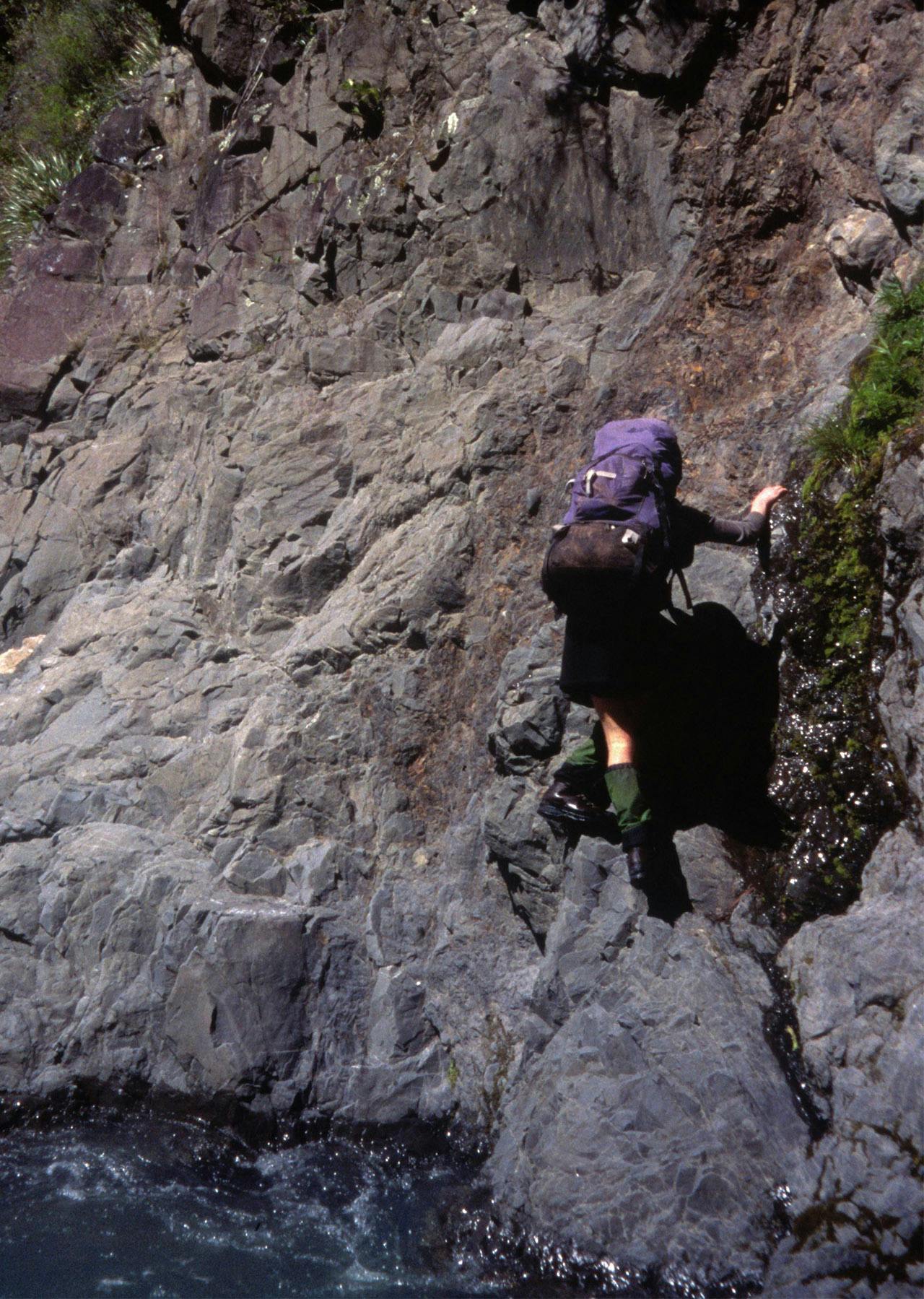
Bypassing a nasty gorge in the Oronui. Photo: Richard Davies
A wild and untamed land, with big rivers, sharp ridges and wild cattle
The steep, crumbly Raukumara ridges are cloaked in dense, bushlawyer-choked forest. The fact that the easier travel is in the steep, greasy, log-choked streams says a lot about this wild place.
Negotiating the massive Motu River on foot is a serious challenge, but if you want to complete this wild crossing you’ll need to. Then it’s up is the Mangatutara Stream, smack bang in the middle of the least touched part of New Zealand. Wild bulls and big pigs stalk the forest and river flats here. If you are lucky, Oronui Hut will mark your last night in the hills. From here you can tackle the bush lawyer infested ridge to Mt Hikurangi, try and climb the (possibly inviolate) leatherwood-festooned bluffs on the south faces of the Whanokao massif or descend the Oronui, through numerous small gorges, back to civilisation.
By the time you reach Pakihiroa Station you’ll be ready for a less scary challenge for your next tramp.
Lake Stream Tops, Victoria Forest Park
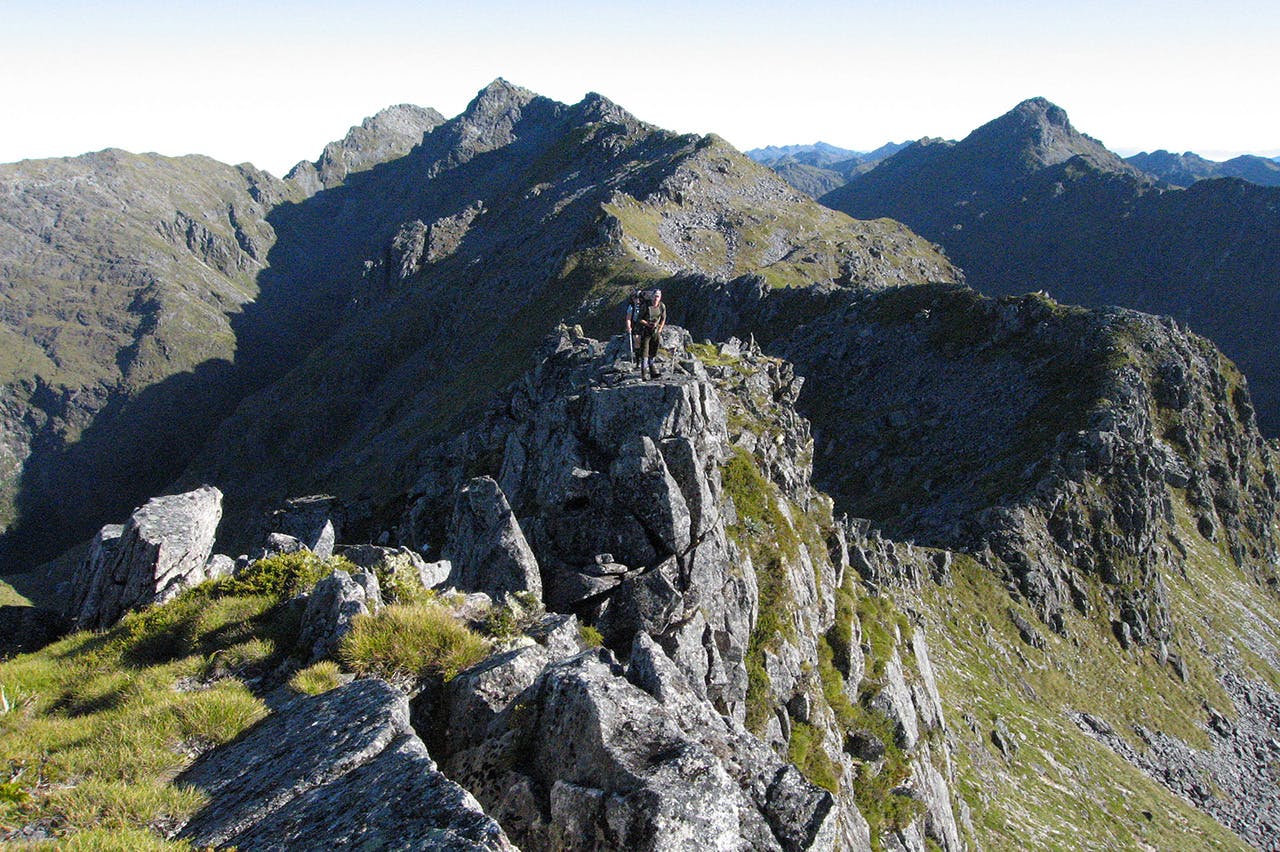
Traversing Lake Stream tops. Photo: Chris Burtonshaw
Classic tramping on seldom visited granity tops
Tucked in between the Paparoas and the Spenser and Nelson Lakes mountains is a dramatic and infrequently travelled range of granite peaks. A challenging blend of rock tors and easy rolling ridge top travel typify tramping here and the topography has sometimes got more in common with the Southern Lakes region than it has with its nearby ranges.
A classic trip that takes in a sample of this terrain, with some exposed scrambling in only a couple of spots is to enter the range via Lake Stream and gain the tops north of the Lake Stream Hut via a gully east of Pt1568m. The tarn north of here makes a great overnight spot.
The trip is completed via a traverse of the tops on the true left of Lake Stream and along here some exposed scrambling and route finding is required in places. For trampers looking to get off trail and onto some more challenging (but not terrifying) terrain this is a great trip.
Bannister Ridge, Tararua Forest Park
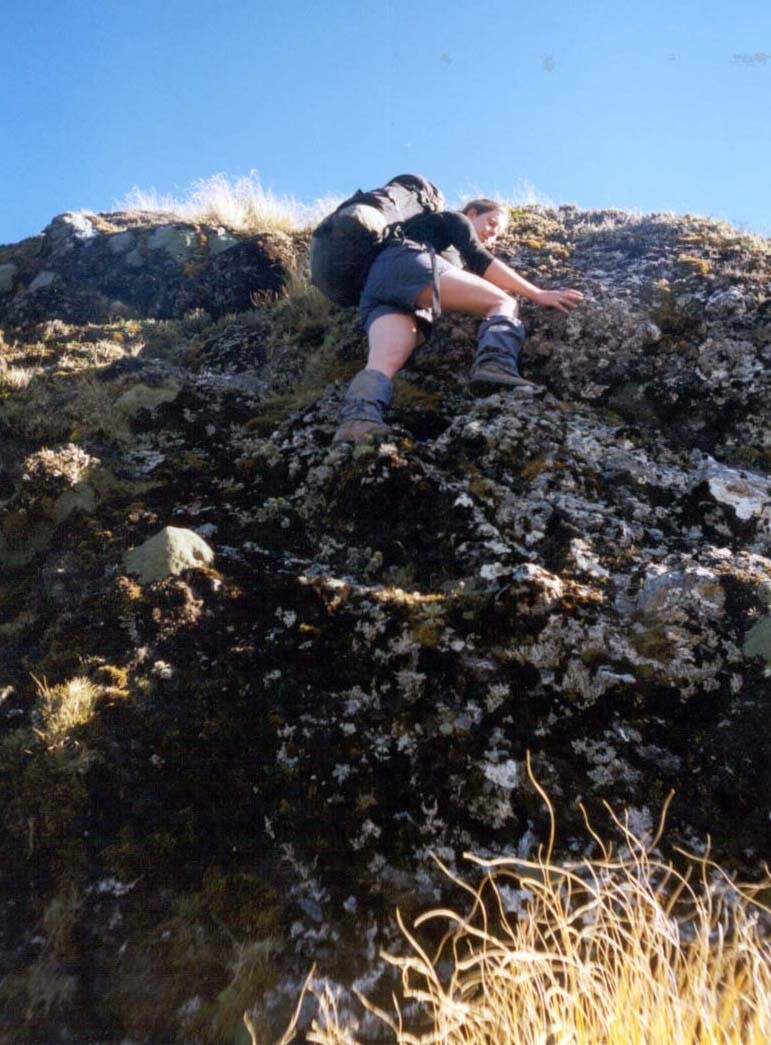
The step on Bannister Ridge. Photo: Richard Davies
A slippery rock step, high on a Tararua ridge
Bannister Ridge is a classic Tararua tops trip. The jagged ridge, bookended by the bulk of Waingawa and the distinctive shape of Arete divides the Waingawa and Ruamahanga rivers and features one of the scariest scrambles in the Tararuas.
Mostly the ridge is typical Tararua tops. Steepish, but the tussock is long and lush and there’s no feeling of exposure. Then you’ll hit the step. The step is only a couple of metres high but is nearly vertical and covered in a black lichen that is extremely slippery when wet. Above that is a small ledge, and then further steep terrain. It is unpleasant to descend in typical cold and damp Tararua weather and a bit of a scramble to surmount going the opposite direction. The feeling of exposure is exacerbated by the steep slopes dropping into the Waingawa.
Time your trip to a nice day and you’ll be able to enjoy expansive views of the central Tararuas while you take a breather.
Dickie Ridge traverse, Westland
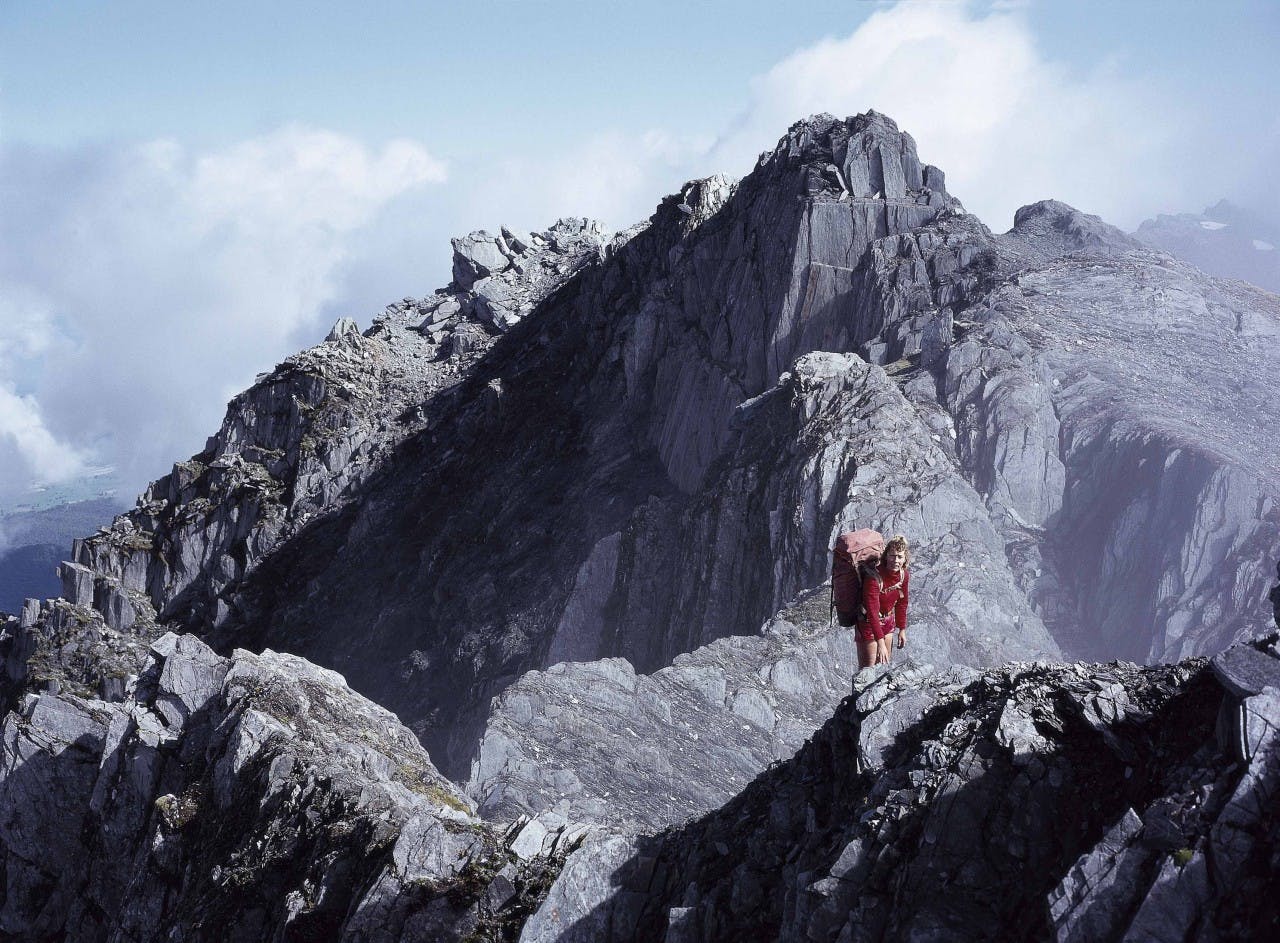
Dickie Ridge is not for the faint-hearted. Photo: Geoff Spearpoint
A rugged, narrow, steep and exposed ridge of rotten schist
The upper part of Dickie Ridge is one of those places I ended up by mistake. The marked route turns off it in the tussock but in mist we missed it. At nightfall the ridge ahead looked spooky and the steep drop over the side looked awful. We camped. The ridge still looked horrible in the morning and we gingerly helped each other along before finding a way off the side that included climbing under a steep snow gut to bypass a schrund (a crevasse separating a glacier from the mountain). This is not an easy ridge and the rock is so bad it can be crumbled in the hand like Weet-Bix. Coupled with steep drop-offs, travel is scary. A rope will certainly be useful, though anchoring options aren’t flash.
The ridge could be incorporated into a transalpine climbing trip from the Mikonui, staying on the ridge to near The Tusk then descending over Raged Peak to the Stag- Reid Creek forks in the upper Waitaha. Head to Ivory Lake and return to the Mikonui Catchment via the usual route over Mt Beaumont and the Tuke River.
But be prepared to be seriously challenged by the rotten rock and bluffs – this is not a ridge for the faint-hearted.





